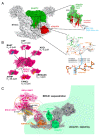BRCA1-A and BRISC: Multifunctional Molecular Machines for Ubiquitin Signaling
- PMID: 33142801
- PMCID: PMC7692841
- DOI: 10.3390/biom10111503
BRCA1-A and BRISC: Multifunctional Molecular Machines for Ubiquitin Signaling
Abstract
The K63-linkage specific deubiquitinase BRCC36 forms the core of two multi-subunit deubiquitination complexes: BRCA1-A and BRISC. BRCA1-A is recruited to DNA repair foci, edits ubiquitin signals on chromatin, and sequesters BRCA1 away from the site of damage, suppressing homologous recombination by limiting resection. BRISC forms a complex with metabolic enzyme SHMT2 and regulates the immune response, mitosis, and hematopoiesis. Almost two decades of research have revealed how BRCA1-A and BRISC use the same core of subunits to perform very distinct biological tasks.
Keywords: BRCA1; BRCC36; DNA repair; RAP80; SHMT2; SUMO; deubiquitination; immune regulation; ubiquitin.
Conflict of interest statement
The author declares no conflict of interest.
Figures




Similar articles
-
Structural Basis of BRCC36 Function in DNA Repair and Immune Regulation.Mol Cell. 2019 Aug 8;75(3):483-497.e9. doi: 10.1016/j.molcel.2019.06.002. Epub 2019 Jun 25. Mol Cell. 2019. PMID: 31253574 Free PMC article.
-
RAP80, ubiquitin and SUMO in the DNA damage response.J Mol Med (Berl). 2017 Aug;95(8):799-807. doi: 10.1007/s00109-017-1561-1. Epub 2017 Jul 5. J Mol Med (Berl). 2017. PMID: 28681078 Free PMC article. Review.
-
Three-Dimensional Architecture of the Human BRCA1-A Histone Deubiquitinase Core Complex.Cell Rep. 2016 Dec 20;17(12):3099-3106. doi: 10.1016/j.celrep.2016.11.063. Cell Rep. 2016. PMID: 28009280 Free PMC article.
-
Autologous K63 deubiquitylation within the BRCA1-A complex licenses DNA damage recognition.J Cell Biol. 2022 Sep 5;221(9):e202111050. doi: 10.1083/jcb.202111050. Epub 2022 Aug 8. J Cell Biol. 2022. PMID: 35938958 Free PMC article.
-
Therapeutic exploitation of tumor cell defects in homologous recombination.Anticancer Agents Med Chem. 2008 May;8(4):448-60. doi: 10.2174/187152008784220267. Anticancer Agents Med Chem. 2008. PMID: 18473729 Review.
Cited by
-
hu.MAP3.0: Atlas of human protein complexes by integration of > 25,000 proteomic experiments.bioRxiv [Preprint]. 2024 Oct 15:2024.10.11.617930. doi: 10.1101/2024.10.11.617930. bioRxiv. 2024. Update in: Mol Syst Biol. 2025 Jul;21(7):911-943. doi: 10.1038/s44320-025-00121-5. PMID: 39464102 Free PMC article. Updated. Preprint.
-
BRCC36 associates with FLT3-ITD to regulate its protein stability and intracellular signaling in acute myeloid leukemia.Cancer Sci. 2024 Apr;115(4):1196-1208. doi: 10.1111/cas.16090. Epub 2024 Jan 30. Cancer Sci. 2024. PMID: 38288901 Free PMC article.
-
Lys-63-specific deubiquitinase BRCC36 enhances the sensitivity of multiple myeloma cells to lenalidomide by inhibiting lysosomal degradation of cereblon.Cell Mol Life Sci. 2024 Aug 13;81(1):349. doi: 10.1007/s00018-024-05390-1. Cell Mol Life Sci. 2024. PMID: 39136771 Free PMC article.
-
Lysine Fatty Acylation: Regulatory Enzymes, Research Tools, and Biological Function.Front Cell Dev Biol. 2021 Jul 22;9:717503. doi: 10.3389/fcell.2021.717503. eCollection 2021. Front Cell Dev Biol. 2021. PMID: 34368168 Free PMC article. Review.
-
BRCA1-A and LIG4 complexes mediate ecDNA biogenesis and cancer drug resistance.bioRxiv [Preprint]. 2025 Feb 23:2025.02.18.638901. doi: 10.1101/2025.02.18.638901. bioRxiv. 2025. PMID: 40027615 Free PMC article. Preprint.
References
-
- Polge C., Uttenweiler-Joseph S., Leulmi R., Heng A.E., Burlet-Schiltz O., Attaix D., Taillandier D. Deciphering the ubiquitin proteome: Limits and advantages of high throughput global affinity purification-mass spectrometry approaches. Int. J. Biochem. Cell Biol. 2013;45:2136–2146. doi: 10.1016/j.biocel.2013.05.031. - DOI - PubMed
Publication types
MeSH terms
Substances
LinkOut - more resources
Full Text Sources
Miscellaneous

